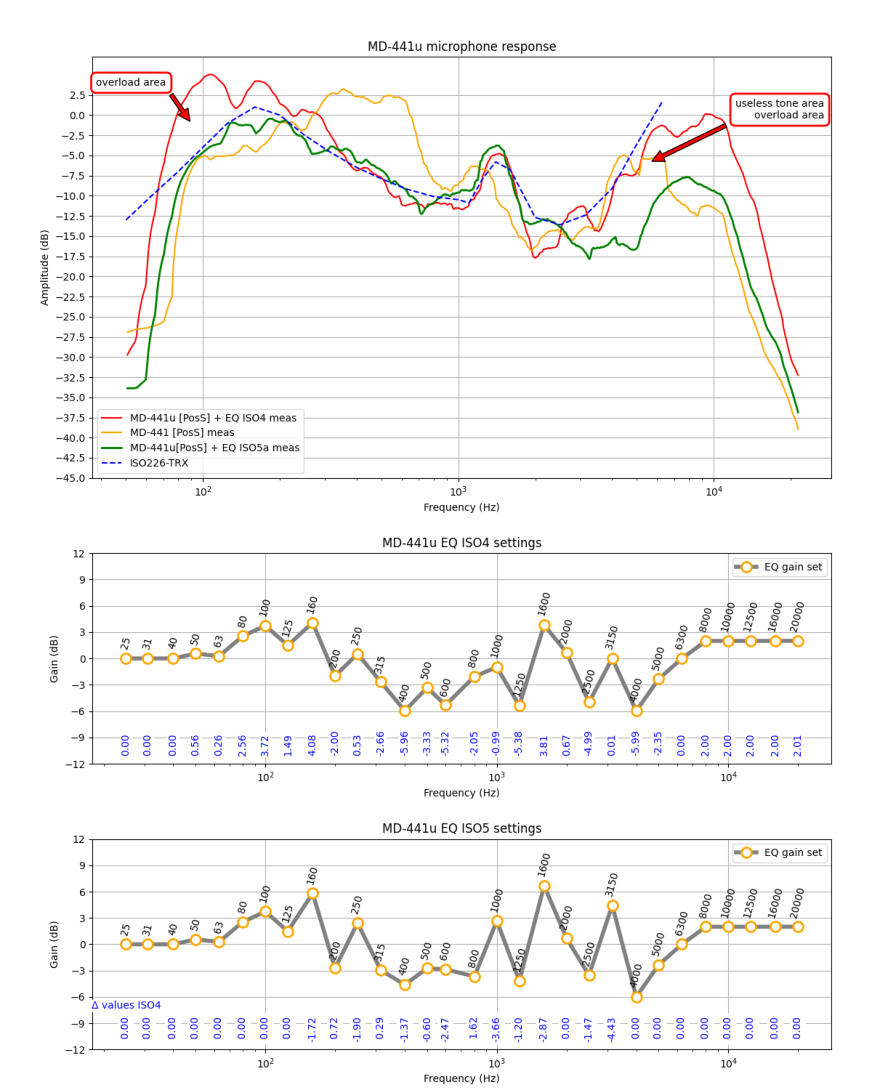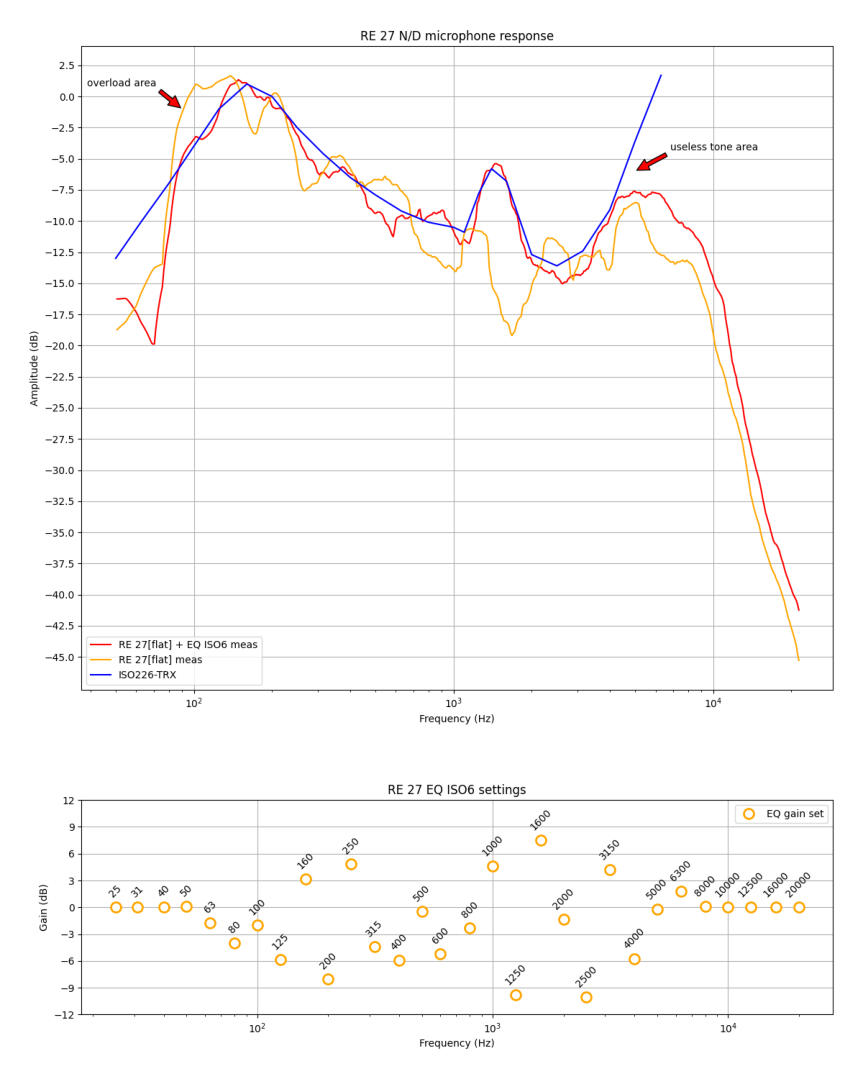

Microphone Equalization
Microphones Measurement 2020
On the following page I will show you the measurements performed with
- ARTA software (1/3oct smoothing and Peak value handling)
- Homebrewed python script for data analysis
Software is not freeware.

Navigate
Electro Voice RE-27 N/D
Before the Sennheiser MD-441u usage, I used an Electro Voice RE-27 N/D. My settings for this microphone starting from good “dark”
modulation to good “DX, aggressive” modulation, nothing for everything.
With the new recognition / knowledge I gave this microphone again a chance, because for some time I enjoyed this microphone too.
Below you see the results from measurment!
a. The yellow curve is the natural response from microphone (all switches of / flat)
-> Interesting for me, was already the good matching, except the 1100 … 2000 Hz area!
b. After the 6. worthful test (ISO6) I found a setting, which was sounding nice.
Background information for my measurements
Since 2014 I was experimenting with different dynamic microphones for my Flexradio Flex-6500 and performed several equalizer settings for the
use with the different microphone. The setups performed in many audio sessions at home, lacking with the right receiving equipment.
This time I decided to find a more trustful way of analysis and decided to perform measurements similar to the measurements I did in 2014 with
a bunch of microphones. During the years I was pleased with the AudioTester software, but could remember from a audiophile friend, that he
used a special software for performing measurements on audio amplifiers and loudspeaker.
So I came to the ARTA software. After some short test, I enjoyed the displayed results of the Spectrum Analyser and decided to perform some
measurements… In addition, the tool allows a flexible setting of the Spectrum Analyzer window.
For my test I used:
- Magnitude axis settings (top = 3dB, range 30dB)
- Frequency range (high = 6000Hz, low = 50Hz)
- Type of filtering = Octave smoothing
- Smothing range = 1/3 octave
- Storage of curve overlay to compare the new result live against old result
- Storage of measurement in .csv or .txt file
AND
I try to use nearly the same text, special words, phrases to a “my special voice generator” for the microphone test.
Sennheiser MD-441u microphone measurement
Over the time I was happy with a found equalizer setup (EQ) together with the Sennheiser MD-441u microphone found on ebay.
Therefore I decided to start a measurement with this setup against the loudness curvature curves from ISO226.
After studing some internet material I decided to use the new standard ISO226:2003, which belongs to my experience of critical frequencies and
also nearly equal characteristic of level decreasing in low / mid range of speech.
Therefore I started some hours of audio testing, equalization, move found settings with an offset and again repeating the stuff.
Then I decided to use a python script to support my logging of measurements with Excel spreadsheet.
After some time, this was also not flexible enough and I extend my script for handling my needs, semi automated.
In the picture below, you see my first step to trimm the microphone response to the ISO226:2003.
Yes, the dotted blue line is again, my interpretation of ISO226:2003, because I found out, that my Flex-6500 was overloaded with the audio level
especially for the two marked areas.
I decided, to stick with my normal microphone gain of the radio and adapt the curve in the way, to prevent overloading conditions and to have
maximum gain for the chain. Therefore I lowered the response to by roughly to -6dB/oct below 125Hz. and limit the level above 5kHz.
What you see is:
- The red curve shows the my 4. setting (ISO4) with overloaded levels for the radio.
- The green curve shows the final 5. setting (ISO5)
- To show you the effect of equalization you have the yellow curve with the microphone response switch to position “S”
In additon the used EQ setting for ISO4 and addition the delta values of EQ setting for ISO5.


With this methode I was able to trimm two totally different microphones to a very useful microphone response for communication and also
both microphones sounding nearly the same.
In general, a good setup is found when:
•
other OMs give you feedback, without asking for modulation rapport
•
you crack the pile-up quickly
•
you are glad with your critical opinion
Conclusion
Audio Setup
DH1RK
Navigate



- FK310 AntennaTuner
- Setup 2008
- Inverted L - Simulation
- Inverted L - Installation
- Inverted L - Matching
- SteppIR - Simulation / 20m band
- SteppIR - Simulation / 17m band
- SteppIR - Simulation / 15m band
- SteppIR - Simulation / 12m band
- SteppIR - Simulation / 10m band
- SteppIR - Simulation / 6m band
- SteppIR - Simulation Overview
- SteppIR - Installation
- HighBands -Yagis
- HighBands -Groundplanes
- Setup 2005





















